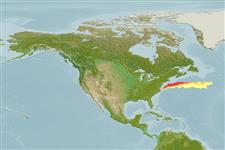Classification / Names
Noms communs | Synonymes | Catalog of Fishes(Genre, Espèce) | ITIS | CoL | WoRMS | Cloffa
>
Stomiiformes (Lightfishes and dragonfishes) >
Stomiidae (Barbeled dragonfishes) > Melanostomiinae
Etymology: Eustomias: Greek, eu = good + Greek, stoma = mouth (Ref. 45335); jimcraddocki: Named for Dr. James E. Craddock of the Woods Hole Oceanographic Institution in recognition of his many contributions to our knowledge of deep-sea fishes (Ref. 51076).
Environment: milieu / climate zone / depth range / distribution range
Écologie
marin bathypélagique; profondeur 0 - 809 m (Ref. 51076). Deep-water; 41°N - 26°N
Distribution
Pays | Zones FAO | Écosystèmes | Occurrences | Point map | Introductions | Faunafri
Northwest Atlantic: known only from slope water south of Georges Bank to the northern Sargasso Sea.
Taille / Poids / Âge
Maturity: Lm ? range ? - ? cm
Max length : 14.3 cm SL mâle / non sexé; (Ref. 51076)
Description synthétique
Morphologie | Morphométrie
Rayons mous dorsaux (Total): 24-25; Rayons mous anaux: 40 - 41. Two pectoral rays (one as tiny rudiment), and a barbel with three branches arising proximal to midlength of the stem, followed by two ovoid swellings (bulbs), either contiguous or separated, and a large terminal bulb. The tear-shaped terminal bulb larger in diameter than the stem or proximal bulbs, with the acuminate end posteriad and upturned dorsally, and bears multiple filaments and bulblets in two groups, one at its anterodorsal surface and one at its terminus. Barbels relatively short (<= 20% standard length) (Ref. 51076).
Probably undergoes some form of vertical migration from below 500 m during the day and within the upper 100 m at night (Ref. 51076).
Life cycle and mating behavior
Maturité | Reproduction | Frai | Œufs | Fécondité | Larves
Sutton, T.T. and K.E. Hartel, 2004. New species of Eustomias (Teleostei: Stomiidae) from the western north Atlantic, with a review of the subgenus Neostomias. Copeia 2004(1):116-121. (Ref. 51076)
Statut dans la liste rouge de l'IUCN (Ref. 130435)
Menace pour l'homme
Harmless
Utilisations par l'homme
Plus d'informations
PaysZones FAOÉcosystèmesOccurrencesIntroductionsStocksÉcologieRégime alimentaireÉléments du régime alimentaireConsommation alimentaireRation
Noms communsSynonymesMétabolismePrédateursÉcotoxicologieReproductionMaturitéFraiRassemblement de ponteFéconditéŒufsDéveloppement de l'œuf
Taille/ÂgeCroissanceLongueur-poidsLongueur-longueurFréquences de longueursMorphométrieMorphologieLarvesDynamique des populations larvairesRecrutementAbondanceBRUVS
RéférencesAquacultureProfil d'aquacultureSouchesGénétiqueElectrophoresesHéritabilitéPathologiesTraitementNutrientsMass conversion
CollaborateursImagesStamps, Coins Misc.SonsCiguateraVitesseType de nageSurface branchialeOtolithesCerveauxVision
Outils
Articles particuliers
Télécharger en XML
Sources Internet
Estimates based on models
Preferred temperature (Ref.
123201): 2.9 - 8.8, mean 3.6 °C (based on 14 cells).
Phylogenetic diversity index (Ref.
82804): PD
50 = 0.5000 [Uniqueness, from 0.5 = low to 2.0 = high].
Bayesian length-weight: a=0.00302 (0.00117 - 0.00783), b=3.12 (2.89 - 3.35), in cm total length, based on LWR estimates for this (Sub)family-body shape (Ref.
93245).
Niveau trophique (Ref.
69278): 4.2 ±0.8 se; based on size and trophs of closest relatives
Résilience (Ref.
120179): Milieu, temps minimum de doublement de population : 1,4 à 4,4 années (Assuming tmax>3).
Fishing Vulnerability (Ref.
59153): Low vulnerability (10 of 100).
